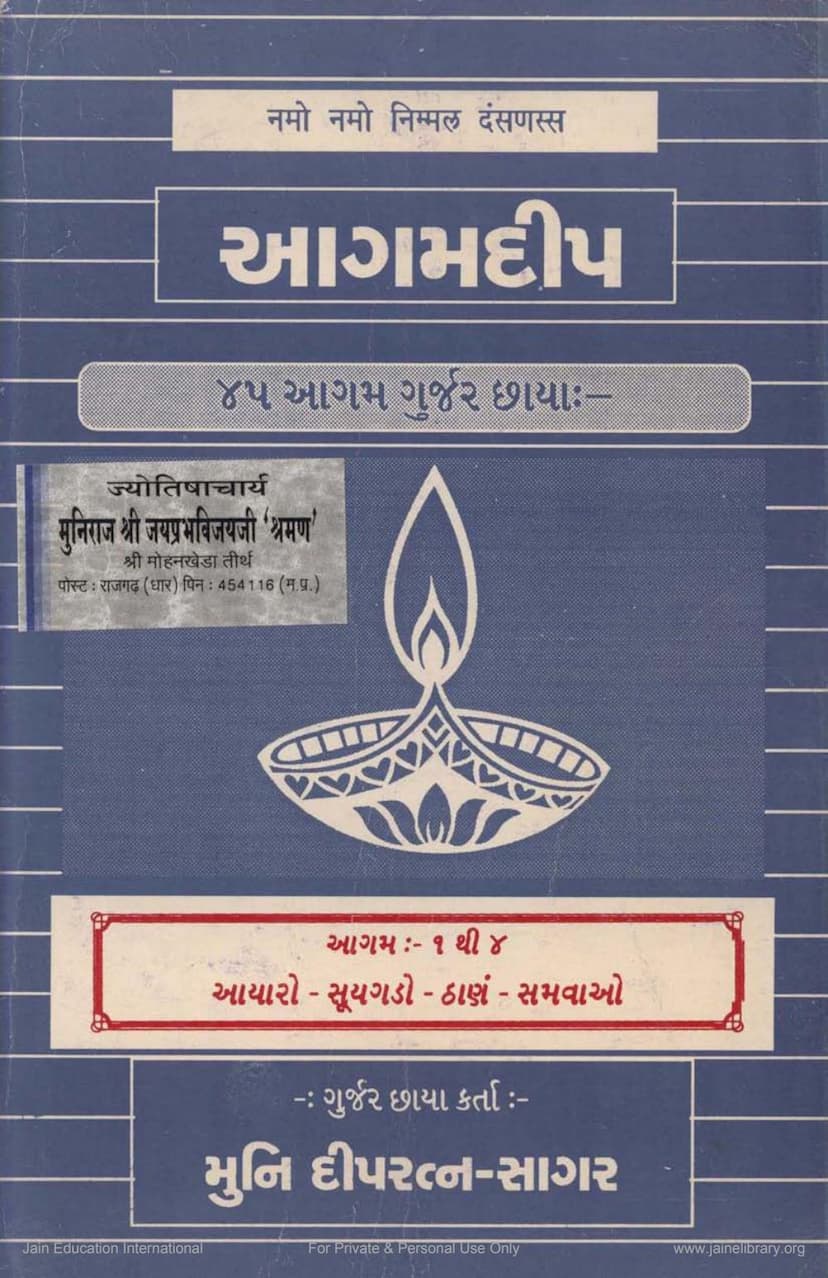Agam Deep 28 TandulVeyaliyam Gujarati Anuvaad
Added to library: September 1, 2025

Summary
Here's a comprehensive summary of the provided Jain text, "Agam Deep 28 TandulVeyaliyam Gujarati Anuvaad," based on the given pages:
Book Title: Agam Deep 28 TandulVeyaliyam Gujarati Anuvaad Author: Muni Deepratnasagar Publisher: Agam Shrut Prakashan
This work is a Gujarati translation and commentary ("Guzar Chhaya") of the Jain Agam scripture, Tandul Veyaliyam, presented as part of the "Agam Deep" series. The text focuses on the detailed explanation and philosophical implications of the Tandul Veyaliyam, a significant scripture in Jainism.
Key Themes and Content:
The provided pages offer a glimpse into the extensive content and structure of this volume. It appears to be a multi-volume project, with this specific book being part of a larger collection dedicated to explaining the Jain Agamas.
-
Structure and Scope: The index on page 4 indicates that the entire "Agam Deep" collection includes multiple volumes, each focusing on different Agam texts. This particular volume, "TandulVeyaliyam," is described as the "Panchmo Payano" (Fifth Section/Volume) and includes a "Gujar Chhaya" (Gujarati Commentary/Explanation). The index also lists other Agam texts like "Aayaro," "Suyagado," "Thanam," "Samavayo," "Vivahapannatti," etc., indicating a comprehensive effort to bring all Agams to Gujarati readers.
-
Content of Tandul Veyaliyam (as per the provided pages):
- Chapter Breakdown: The index (page 4) outlines the specific chapters or sections within this volume:
- Mangal and Dwar Nirupan (Invocation and Gate Description) - Pages 3-42
- Garbha Prakaran (Chapter on the Embryo) - Pages 43-57
- Prani Ni Dash Dasao (Ten States of a Living Being) - Pages 46-48
- Dharma Upadesh and Phal (Religious Discourse and its Results) - Pages 46-48
- Deh Samhanan ane Aahar Adi (Body Structure and Food, etc.) - Pages 49-50
- Kaal Praman (Time Measurement) - Pages 50-51
- Annityatva-Ashuchisva Adi Prarupana (Explanation of Impermanence, Impurity, etc.) - Pages 51-53
- Upadesh - Upsanhar (Discourse - Conclusion) - Pages 53-56
- Detailed Explanation of Human Life and Body (pages 11-24): A significant portion of the text delves into the intricacies of human life, starting from conception and development in the womb. It provides detailed descriptions of:
- Gestation: The duration of time spent in the womb, the formation of the embryo, and the stages of development of bodily parts.
- Birth: The process of birth, potential difficulties, and the gender determination based on the union of semen and ovum.
- Body Anatomy and Physiology: Extensive descriptions of the human body's structure, including bones, joints, muscles, veins, nerves, internal organs (liver, kidneys, heart, lungs), and their functions. It meticulously details the composition of the body, its impurities, and its transient nature.
- Life Stages: The text outlines ten stages of life, from infancy to old age, describing the physical and mental changes associated with each.
- The Human Body as Impermanent and Impure: A recurring theme is the emphasis on the body's impermanence, its composition of impure elements, and the inevitability of decay and death. It contrasts the external beauty with the internal reality of the body, urging detachment and renunciation.
- The Nature of Happiness and Suffering: The text discusses the fleeting nature of worldly pleasures and the pervasiveness of suffering in life, linking it to attachment and the cycle of birth and death.
- The Importance of Dharma: It strongly advocates for the practice of Dharma (righteous conduct) as the only path to liberation and true happiness. It highlights that wealth, family, and status are temporary and cannot accompany one at the time of death.
- The Role of Women: A substantial section is dedicated to a critical and often negative portrayal of women, describing them as cunning, deceitful, and a source of attachment and bondage for men. This section uses strong language to illustrate the perceived flaws and dangers associated with women.
- Time and Measurement: The text includes discussions on various units of time measurement, such as 'shwas' (breath), 'stok', 'lav', 'muhurta', 'din', 'raatr', 'paksh', 'maas', 'rutu', 'ayan', 'samvatsar', and their correlations. It also touches upon measurements related to food intake and bodily quantities.
- Ancient vs. Modern Times: It contrasts the longevity, physical perfection, and virtuous nature of humans in ancient eras (Yuglik, Chakravarti, etc.) with the declining lifespan, physical imperfections, and moral decay of present times, attributing this to the influence of the Avsarpini period and the increase of vices like anger, pride, deceit, and greed.
- Chapter Breakdown: The index (page 4) outlines the specific chapters or sections within this volume:
-
Sponsorship and Publication: The introductory pages (2, 3, 5, 6) acknowledge various individuals and organizations who have supported the publication financially. This indicates a community effort to preserve and disseminate Jain scriptures. The publisher, "Agam Shrut Prakashan," is identified as releasing this work.
-
Purpose: The "Guzar Chhaya" (Gujarati commentary) aims to make the profound teachings of the Tandul Veyaliyam accessible to Gujarati-speaking audiences, providing detailed explanations and insights into the spiritual and philosophical aspects of Jainism. The emphasis on the body's impermanence and the call to righteous action points towards the ultimate goal of liberation (Moksha).
In essence, "Agam Deep 28 TandulVeyaliyam Gujarati Anuvaad" is a scholarly and detailed explanation of a key Jain scripture, offering profound insights into the nature of existence, the human body, the cycle of life and death, and the paramount importance of following the path of Dharma for spiritual liberation. The text is rich in its descriptive language, particularly concerning the physical body and its ephemeral nature.